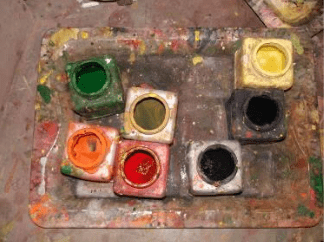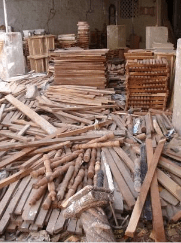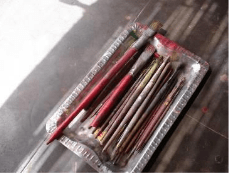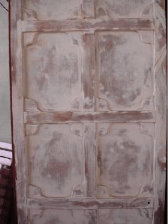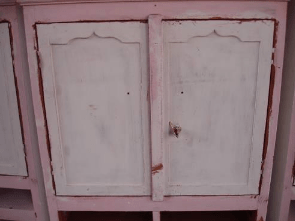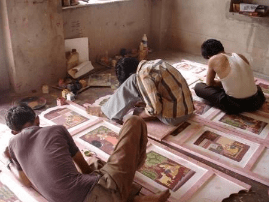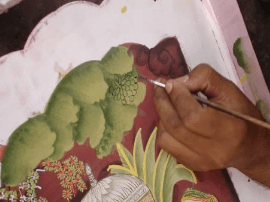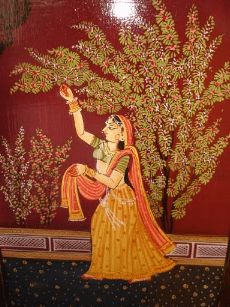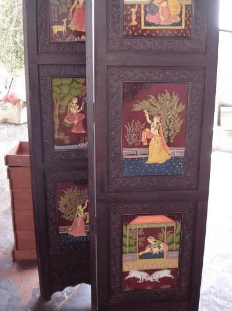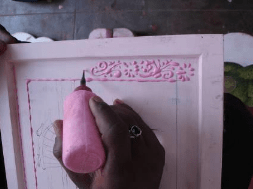Painted Wood Craft
Painted Wood Craft has been an integral part of the rich tradition of handicrafts in India. The availability of a wide variety of wood enabled the flourishing of several distinctive wood crafts and styles.
Carving, inlay with copper and brass wires, painting, lacquering, appliqué, and marquee try are some of the unique wood craft forms that have been prevalent in the country for centuries.
The use of wood craft in architecture such as carved wooden doors, columns, balconies/jharokas, ceilings, etc was an integral part of the cultural life in ancient and medieval India.
Each region had a distinctive style depending on the availability of local raw materials and local traditions prevalent. It is believed that wood craft received great patronage under the Vijayanagar empire in Southern India.
Karnataka, Tamil Nadu, Andhra Pradesh, and Kerala had rich traditions of wood carving especially evident in temples.
Chariots for carrying deities during festive occasions, religious figurines, and temple structures were carved in wood, sandalwood being the most popular. Assam with its dense forests has been equally popular for its wood carving.
Gujarat and Rajasthan has also been representative of exquisite wood work. Palaces and havelis with intricate carved and painting work are examples. Elements of Islamic culture are noticeable in intricate lattice or jaali work and floral motifs.
Barmer, Jodhpur, Kishangarh, and Rampur are known for their distinctive styles of wood furniture making. Uttar Pradesh has been another important center for wood craft with Saharanpur, Nagina, and Mainpuri specializing in carved and inlay work, the latter introduced through Islamic influence.
Artisans engaged in wood inlay with metal wires in UP were earlier working with metal craft. Kashmir has been well known for its excellence in walnut carving.
The legacy of wood craft traditions can be seen today in traditional Kashmiri houses with overhanging balconies that are enclosed in fine lattice work called acche–dar and azli–pinjra.
Besides these well-known examples, wood craft has been practiced in almost all regions of the country. Paper thin bowls for Jain monks are made out of rohida wood in Pali district of Rajasthan.
The hill regions of Himachal Pradesh and Uttaranchal show skilled craftsmanship in wood craft with intricate etchings on pillars and doors. Wooden boxes for storing grains and bowls are other examples from these regions.
The erstwhile rulers patronized wood craft in architecture. The tradition has become almost extinct now. Today craftsmen are engaged in making furniture, products for everyday use, toys, and decorative items that are in demand in the market.
Painted Wood Craft
Painted wood craft is an important component of wood crafts in India. Hand-painted toys of Kondapalli and Nirmal in Andhra Pradesh being made for generations are well known. Gujarat and Rajasthan have a rich heritage of hand painted wood furniture.
Sankheda in Gujarat and Kishangarh in Rajasthan are important centers. Sankheda furniture is made of teakwood and painted in traditional colors of gold, silver, maroon, green, vermilion, and brown.
In Kishangarh artisans use rosewood, mango wood, and babul for making the furniture that is painted in Mughal motifs. Emboss work on furniture made in Kishangarh style is a new development that has gained significant popularity.
Painted Wood Craft Regions of production
Some of the well known centers of wood craft in India are:
- Nirmal and Kondapalli in Andhra Pradesh -painted toys made of punki and burgu wood;
- Etikopakka -wooden lacquerware
- Karnataka –painted toy making in Kinhal; rosewood and sandalwood carving; wood inlay
- Delhi –sandalwood carving
- Sankheda in Gujarat –wooden lacquer ware furniture;
- Surat – marquee try or mosaic work known as sadeli; wood block making for hand printing
- Saharanpur, Nagina, and Mainpuri in Uttar Pradesh -wood carving and brass inlay known as tarkashi.
- Nagina is known for carved wooden combs in ebony wood;
- Varanasi –painted toys
- Kashmir -walnut woodwork that is either carved or plain with polish
- Brahmour and Chamba in Himachal Pradesh –wood carving
- Barmer, Jodhpur, Jaisalmer, Kishangarh in Rajasthan for carved and painted furniture
- Bastar in Madhya Pradesh -incised wood combs, dancing sticks, and other artifacts
- Arunachal Pradesh –bright painted masks made out of single block of wood
- Orissa and West Bengal – painted items of everyday use and masks depicting religious and mythological figures used in festivals. Plain wood carving using gambhari wood is popular in Cuttack in Orissa.
- Tamil Nadu and Kerala –rosewood carving
Painted Wood Craft Producer communities
Wood craft is practiced in almost all regions of the country each with its own distinctive signature. Hindu, Muslim, and tribal communities are all engaged in various forms of wood craft.
In case of painted wooden furniture of Kishangarh and Jodhpur in Rajasthan, many of the artisans skilled in miniature paintings are now involved in similar painting work on the furniture.
Brahmins, Mahajans, Soni, Saini, and Kumhars are some of the communities engaged in painted wood craft in Rajasthan.
Painted Wood Craft Raw Materials
Wood -babool wood (acacia arabica )/mango wood (150 –200/cubic sq ft), primer, colors (800-1000/kg), babul gond/gum, potassium permanganate ,chandras (lac grains in acid priced 350-500/kg), harmach powder (for antique finish), wood preservative, varnish.
For embossing: chalk mitti/ceramic powder, fevicol, zinc, red color
The raw materials are purchased from Kishangarh or neighboring Jaipur and Ajmer.
Painted Wood Craft Tools
Brushes for painting and polishing
Painted Wood Craft Process
First, the carpenter prepares the basic structure of the furniture, for example a window screen, chair, stool, etc. The furniture item is coated with wood preservative.
After the basic furniture piece is ready it is coated with plastic paint/primer. After drying the surface is rubbed with sand paper to smoothen it for painting work that follows.
The painting work begins with the painter sketching the design on the wood surface. The base colors on the motifs are filled in next followed by detailing.
The painter starts from the background details like the sky, trees, leaves, etc. The detailing on human figures is done at the final stage. The face of the figures takes maximum painting time.
It requires a lot of patience and detailing and is worked upon at the last. The painting is now left to dry up. The process of painting is similar to miniature painting work of Rajasthan.
Kishangarh is an important center for miniature art and in fact a number of the artists are now engaged in furniture painting in this place.
Next stage involves coating the painted surface with chandras (a solution of lac grains in acid). Chandras helps to lighten the color palette or what local artists refer to as ‘cooling’ the paints. It reduces the sharpness in colors.
Next it is coated with potassium permanganate for antiquing the painting. Both chandras and potassium permanganate are applied 2-3 times to obtain the desired finish.
Embossing or creating raised pattern on the furniture is the next stage. It usually forms a border to the central painting. Ceramic powder, fevicol, zinc, and red color are mixed together to prepare a thick paste. This paste is filled in a tube and squeezed from it to create the desired design. The pattern is then left to dry.
Harmach powder is now mixed with water to make a rust orange palette that is applied on the embossed area and plain wood border. Final stage involves coating with varnish.
Products and their uses
furniture: chairs with painted backs, tables, low stools/chaukis, cabinets, screens/room dividers, almirahs, bookshelves, sideboards, mirror frames
Painted artifacts: dancing figurines, musicians, dwarpalas/guards at the door, incense holders, napkin holders, and animals such as elephants, horses, and camels
Miscellaneous
Wood craft in India has undergone several phases of transition. Its role in contemporary architectural designs is almost extinct as wood is now scarce and expensive.
Also, wood crafts flourished under royal patronage that was lost with the decline of empires such as Vijayanagar in South and Mughalin north. Teak wood and ebony wood were widely used for crafting furniture in earlier times.
Their scarcity has led to the use of several other varieties of wood like rosewood, sal, mango, babool, walnut, etc depending on local availability. While some crafts declined over time there were some like walnut craft of Kashmir that received great encouragement from the European traders. Its popularity continues till date. Hardwood furniture received great impetus under the Portuguese.
In contemporary time’s furniture, items of everyday use, toys, and decorative products in wood have gained popularity. Carved, painted, and lacquered furniture from Rajasthan and Gujarat is widely sought after in the domestic as well as export market.
Antique finish furniture from Rajasthan is another popular category especially abroad. Wooden furniture crafts have undergone many changes in design as the fusion between traditional and modern styles is in huge demand in the market.
Emboss work on furniture in Kishangarh, Rajasthan, is a design innovation that has gained appreciation in the market.
In terms of technology, artisans continue to work with simple tools and traditional techniques that lend a unique flavor to their products.
Many traditional motifs have been retained such as lattice or jaali work, Mughal motifs in painted furniture of Rajasthan, fretwork and anguri work of Uttar Pradesh, etc.


